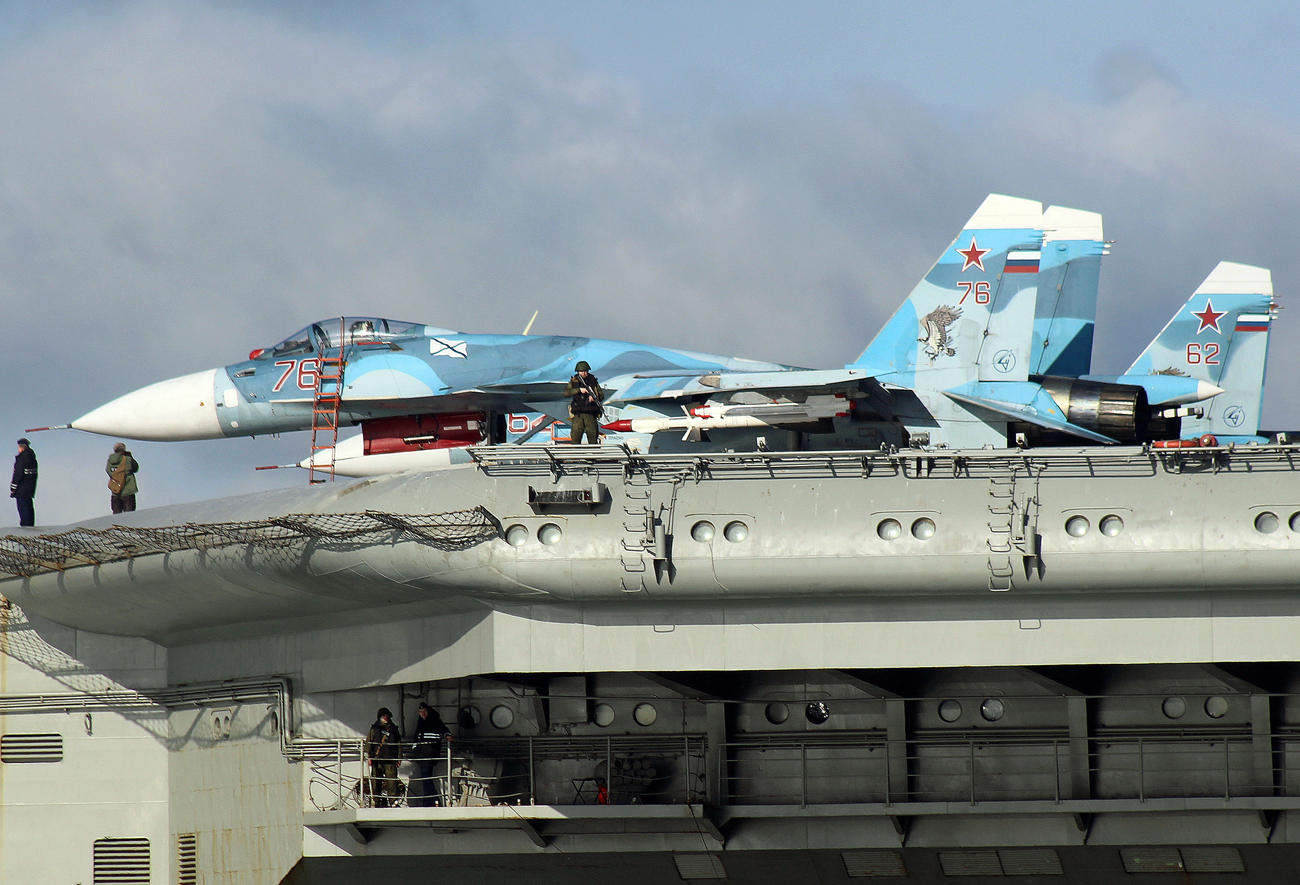
Sukhoi Su-33 Flanker-D fighters aboard the aircraft carrier Admiral Kuznetsov sails together with the Russian Northern Fleet's carrier battle group.
RIA NovostiThe Russian television channel Zvezda TV has shown images of the drills involving the Su-22s and MiG-29KUBs stationed on Russia’s Admiral Kuznetsov aircraft carrier's air wing. The footage was taken in the Mediterranean Sea as the ship neared the coast of Syria, where it is to take part in Moscow’s military campaign against rebels seeking to overthrow Syrian leader Bashar al-Assad.
The fighters carried out the training flights "empty," that is, without any weapons.
The air unit consists of the Admiral Kuznetsov aircraft carrier, the Peter the Great heavy nuclear missile cruiser, and the Severomorsk and Vice Admiral Kulakov large anti-submarine ships and support vessels.
Su-22s and MiG-29KUBs take off from Russia’s Admiral Kuznetsov aircraft carrier. Source: Zvezda TV/YouTube
In the words of editor-in-chief of Vzlyot (Take-Off) magazine Andrei Fomin, the deck MiGs are among the most modern serial fighters from the 4++ generation.
"Despite its external resemblance to the MiG-29 ground version, this is a completely different machine,” said Fomin. “The difference is in its stealth technology, the new air refueling system, a folding wing and its mechanization, thanks to which the plane can take off at a shortened distance and land at a lesser landing speed.”
Fomin notes that the Su-33 was created as a plane that dominates in the air, that is, as a full-fledged fighter-interceptor.
The MiG-29K/KUB, meanwhile, is more of a multi-faceted machine, designed for the air defense of naval forces, as well as for striking surface and ground targets with high-precision guided weapons during the day and at night in any atmospheric conditions.
During the Syrian campaign the Su-33s taking off from the Admiral Kuznetsov will use free-falling bombs with their new fire adjustment system. The MiG-29K/KUB will be equipped with adjustable bombs and missiles, aimed at the targets with the Glonass system.
Despite the planned nature of the aircraft carrier group's mission, the combat machines are preparing to test new Russian weapons for the first time in Syria.
The Admiral Kuznetsov's Ka-52K combat helicopters will test the Germes super long-range anti-tank guided missiles.
Thanks to the new weapon the helicopters will be able to destroy enemy tanks, reinforcements and troops at a distance of up to 20 miles (30 kilometers). Equivalent Russian and foreign systems (Atak, Vikhr, Hellfire, etc.) can travel for no more than 10 kilometers.
According to Viktor Litovkin, a retired colonel and military expert at the TASS news agency, the Germes will be used against well-protected enemy objects such as weapons enterprises and improvised explosive devices, as well as against command posts and temporary pillboxes.
"Based on the results from their combat use, a decision will be made whether to send the missiles back to the plant to be perfected or adopt them as official weapons," said Litovkin.
"Sending the 'Admiral' to Syria is a test of our aircraft striking group's operational and technical capabilities and possibilities, since earlier Russia never used aircraft carriers in real combat conditions," explained Viktor Murakhovsky, editor-in-chief of the Arsenal Otechestva (Arsenal of the Fatherland) magazine.
There are currently 15 Su-33 and MiG-29K/KUB fighters on board the aircraft carrier, as well as more than 10 Ka-52K, Ka-27 and Ka-31 helicopters.
The air group's main objective will be to guarantee air defense for Russia’s air force and support for Syrian governmental forces during combat with militants.
"The air group's possibilities concerning ground targets are limited. There will not be a turning point in the war with the militants. The main role in the war with the terrorists is being played by Assad's forces," said Murakhovsky.
All rights reserved by Rossiyskaya Gazeta.
Subscribe
to our newsletter!
Get the week's best stories straight to your inbox